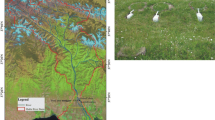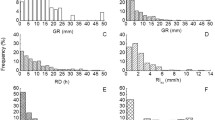Abstract
The runoff coefficient, defined as the portion of rainfall that becomes direct runoff during an event, is a key concept in engineering hydrology and is widely used for design. Also, it is useful for understanding the flood frequency controls in a particular hydrologic or climatic regime. In this paper, the runoff coefficient characteristics and the dominant influence factors of riparian Myricaria squamosa Desv. shrubs were researched based on the data of runoff coefficient, rainfall depth, rainfall intensity, the 10-min maximum rainfall intensity, and antecedent soil moisture measured in Qinghai Lake basin, which will help us to recognize the runoff coefficient and the influence factors of riparian shrubs in highly cold and semiarid districts. The runoff coefficient of riparian M. squamosa Desv. shrubs in the study area is very small (the mean value is 0.39 %). Rainfall depth, rainfall intensity, and the 10-min maximum rainfall intensity are the dominant controls on runoff coefficient of riparian M. squamosa Desv. shrubs over Qinghai Lake basin. Runoff coefficient and rainfall depth have a logarithmic function relationship, and runoff coefficient increases with the increasing of rainfall depth significantly. The relationships between runoff coefficient and rainfall intensity/the 10-min maximum rainfall intensity are both logarithmic, both rainfall intensity and the 10-min maximum rainfall intensity significantly influence runoff coefficient in the study area, and the 10-min maximum rainfall intensity influences runoff coefficient more significantly. Relationships between runoff coefficient and antecedent soil moisture of 10 and 30 cm underground are not significant. This is because of the low soil moisture of 10 and 30 cm underground due to the bad soil water retention in the study area. Significant linear relationships were found between runoff coefficient and antecedent soil moisture of 60 and 80 cm underground, where runoff coefficient decreases with the increasing of antecedent soil moisture of 60 and 80 cm underground.









Similar content being viewed by others
References
Barazzuoli P, Izzo S, Menicori P, Micheluccini M, Salleolini M (1989) A new practical aid to regional hydrogeologic planning: the runoff coefficient map. Environ Manag 13:613–622
Cao SK, Chen KL, Cao GC, Zhang L, Ma J, Yang L, Lu BL, Chen L, Lu H (2011) 2011 3rd International Conference on Environmental Science and Information Application Technology (ESIAT 2011)—The analysis of characteristic and spatial variability for soil organic matter and organic carbon around Qinghai Lake. Procedia Environ Sci 10:678–684
Cerdan O, Le Bissonnais Y, Govers G, Leconte V, van Oost K, Couturier A, King C, Dubreuil N (2004) Scale effects on runoff from experimental plots to catchments in agricultural areas in Normandy. J Hydrol 299:4–14
Colman SM, Yu S, An ZS, Shen J, Henderson ACG (2007) Late Cenozoic climate changes in China’s western interior: a review of research on Lake Qinghai and comparison with other records. Quat Sci Rev 26:2281–2300
Coronato FR, Bertiller MB (1996) Precipitation and landscape related effects on soil moisture in semi-arid range lands of Patagonia. J Arid Environ 34:1–9
Deng SC, Dong HL, Lv G, Jiang HC, Yu BS, Bishop ME (2010) Microbial dolomite precipitation using sulfate reducing and halophilic bacteria: results from Qinghai Lake, Tibetan Plateau, NW China. Chem Geol 278:151–159
Dos Reis Castro NM, Auzet A-V, Chevallier P, Leprun J-C (1999) Land use change effects on runoff and erosion from plot to catchment scale on the basaltic plateau of Southern Brazil. Hydrol Process 13:1621–1628
Gottschalk L, Weingartner R (1998) Distribution of peak flow derived from a distribution of rainfall volume and runoff coefficient, and a unit hydrograph. J Hydrol 208:148–162
Henderson ACG, Holmes JA, Zhang JW, Leng MJ, Carvalho LR (2003) A carbon and oxygen-isotope record of recent environment change from Lake Qinghai, NE Tibetan Plateau. Chin Sci Bull 48:1463–1468
Holsten A, Vetter T, Vohland K, Krysanova V (2009) Impact of climate change on soil moisture dynamics in Brandenburg with a focus on nature conservation areas. Ecol Model 220:2076–2087
Hupet F, Vanclooster M (2002) Intraseasonal dynamics of soil moisture variability within a small agricultural maize cropped field. J Hydrol 261:86–101
Ji JF, Shen J, Balsam W, Chen J, Liu LW, Liu XQ (2005) Asian monsoon oscillations in the northeastern Qinghai-Tibet Plateau since the late glacial as interpreted from visible reflectance of Qinghai Lake sediments. Earth Planet Sci Lett 233:61–70
Jin ZD, You CF, Wang Y, Shi YW (2010) Hydrological and solute budgets of Lake Qinghai, the largest lake on the Tibetan Plateau. Quat Int 218:151–156
Jost G, Schume H, Hager H, Markart G, Kohl B (2012) A hillslope scale comparison of tree species influence on soil moisture dynamics and runoff processes during intense rainfall. J Hydrol 420–421:112–124
Li XY, Xu HY, Sun YL, Zhang DS, Yang ZP (2007) Lake-level change and water balance analysis at Lake Qinghai, west China during recent decades. Water Resour Manag 21:1505–1516
Li XZ, Liu WG, Xu LM (2012) Carbon isotopes in surface-sediment carbonates of modern Lake Qinghai (Qinghai-Tibet Plateau): implications for lake evolution in arid areas. Chem Geol 300–301:88–96
Lister GS, Kelts K, Chen KZ, Yu JQ, Niessen F (1991) Lake Qinghai, China: closed basin lake levels and the oxygen isotope record for ostracoda since the latest Pleistocene. Palaeogeogr Palaeoclimatol Palaeoecol 84:141–162
Liu XQ, Shen J, Wang SM, Wang YB, Liu WG (2007) Southwest monsoon changes indicated by oxygen isotope of ostracode shells from sediments in Lake Qinghai since the late Glacial. Chin Sci Bull 52:539–544
Liu WG, Liu ZH, Fu MY, An ZS (2008) Distribution of the C37 tetra-unsaturated alkenone in Lake Qinghai, China: a potential lake salinity indicator. Geochim Cosmochim Acta 72:988–997
Liu WG, Li XZ, Zhang L, An ZS, Xu LM (2009) Evaluation of oxygen isotopes in carbonate as an indicator of lake evolution in arid areas: the modern Qinghai Lake, Qinghai-Tibet Plateau. Chem Geol 268:126–136
Luo Z, Zhou YC, Li J, Shao J, Yang T, Wang JY, Lei FM, Li TX, Xing Z, Yan BP (2011) 2011 3rd International Conference on Environmental Science and Information Application Technology (ESIAT 2011)—Cyberinfrastructure for joint research in Qinghai Lake Nature Reserve. Procedia Environ Sci 10:1781–1790
Merz R, Blӧschl G (2009) A regional analysis of event runoff coefficients with respect to climate and catchment characteristics in Austria. Water Resour Res 45:1–19
Merz R, Blӧschl G, Parajka J (2006) Spatio-temporal variability of event runoff coefficients. J Hydrol 331:591–604
Mishra SK, Tyagi JV, Singh VP, Singh R (2006) SCS-CN-based modeling of sediment yield. J Hydrol 324:301–322
Naef F (1993) Der Abflusskoeffizient: einfach und praktisch? In: Aktuelle Aspekte in der Hydrologie, Zürcher Geographische Schriften, Heft 53, Verlag Geographisches Institut ETH Zürich, pp 193–199
Norbiato D, Borga M, Merz R, Blöschl G, Carton A (2009) Controls on event runoff coefficients in the eastern Italian Alps. J Hydrol 375:312–325
Ridolfi L, D’Odorico P, Porporato A, Rodriguez-Iturbe I (2003) Stochastic soil moisture dynamics along a hillslope. J Hydrol 272:264–275
Savenije HHG (1996) The runoff coefficient as the key to moisture recycling. J Hydrol 176:219–225
Sherman L (1932) Streamflow from rainfall by unit hydrograph method. Engineering News Records 108, Chicago, pp 501–505
Shi ZH, Chen LD, Fang NF, Qin DF, Cai CF (2009) Research on the SCS-CN initial abstraction ratio using rainfall-runoff event analysis in the Three Gorges Area, China. Catena 77:1–7
Singh PK, Bhunya PK, Mishra SK, Chaube UC (2008) A sediment graph model based on SCS-CN method. J Hydrol 349:244–255
Singhl JS, Milchunas DG, Lauenroth WK (1998) Soil water dynamics and vegetation patterns in a semiarid grassland. Plant Ecol 134:77–89
Sriwongsitanon N, Taesombat W (2011) Effects of land cover on runoff coefficient. J Hydrol 410:226–238
Stoll S, Franssen H-JH, Bárdossy A, Kinzelbach W (2013) On the relationship between atmospheric circulation patterns, recharge and soil moisture dynamics in Switzerland. J Hydrol 502:1–9
Sun YJ, Lai ZP, Madsen D, Hou GL (2012) Luminescence dating of a hearth from the archaeological site of Jiangxigou in the Qinghai Lake area of the northeastern Qinghai-Tibetan Plateau. Quat Geochronol 12:107–110
US Soil Conservation Service(1956) National Engineering Handbook. Chapter 10. Supplement A,Section 4:Hydrology. Soil Conservation Service, US Department of Agriculture, Washington DC
Wainwright J, Parsons AJ (2002) The effect of temporal variations in rainfall on scale dependency in runoff coefficients. Water Resour Res 38:7-1∼7-10
Wang XP, Yang HD, Gong P, Zhao X, Wu GJ, Turner S, Yao TD (2010) One century sedimentary records of polycyclic aromatic hydrocarbons, mercury and trace elements in the Qinghai Lake, Tibetan Plateau. Environ Pollut 158:3065–3070
Xiao B, Wang QH, Fan J, Han FP, Dai QH (2011) Application of the SCS-CN model to runoff estimation in a small watershed with high spatial heterogeneity. Pedosphere 21:738–749
Xiao J, Jin ZD, Zhang F, Wang J (2012) Solute geochemistry and its sources of the groundwaters in the Qinghai Lake catchment, NW China. J Asian Earth Sci 52:21–30
Xu H, Ai L, Tan LC, An ZS (2006) Stable isotopes in bulk carbonates and organic matter in recent sediments of Lake Qinghai and their climatic implications. Chem Geol 235:262–275
Xu LB, Wu FC, Zheng J, Xie QL, Li HX, Liao HQ, Zhao XL, Guo F (2011) Sediment records of Sb and Pb stable isotopic ratios in Lake Qinghai. Microchem J 97:25–29
Xu H, Lan JH, Liu B, Sheng EG, Yeager KM (2013) Modern carbon burial in Lake Qinghai, China. Appl Geochem 39:150–155
Yan JP, Hinderer M, Einsele G (2002) Geochemical evolution of closed-basin lakes: general model and application to Lakes Qinghai and Turkana. Sediment Geol 148:105–122
Zeng C (2012) 2011 International conference on environmental science and engineering (ICESE 2011)—Evaluation of oxygen stable-isotope fractionation among co-existed carbonates in the sediments of Lake Qinghai. Procedia Environ Sci 12:851–855
Zhang NN, Cao JJ, Liu SX, Zhao ZZ, Xu HM, Xiao S (2014) Chemical composition and sources of PM2.5 and TSP collected at Qinghai Lake during summertime. Atmos Res 138:213–222
Zhu JF, Chen KL, Cao SK, Chen L, Wu YP, Lu BL, Wang YS (2011) 2011 3rd International Conference on Environmental Science and Information Application Technology (ESIAT 2011)—Spatial variability analysis of soil salt and its component ions in Qinghai Lake region. Procedia Environ Sci 10:2431–2436
Acknowledgments
This research is supported by the National Science and Technology Support Plan (2007BAC30B02) and the National Nature Science Foundation of China (NSFC 40599423, 41101553). All of these supports are appreciated.
Author information
Authors and Affiliations
Corresponding author
Rights and permissions
About this article
Cite this article
Li, Y., Li, X. & Li, G. Runoff coefficient characteristics and its dominant influence factors of the riparian Myricaria squamosa Desv. shrubs over Qinghai Lake basin, NE Qinghai-Tibet Plateau. Arab J Geosci 8, 6655–6666 (2015). https://doi.org/10.1007/s12517-014-1738-7
Received:
Accepted:
Published:
Issue Date:
DOI: https://doi.org/10.1007/s12517-014-1738-7




